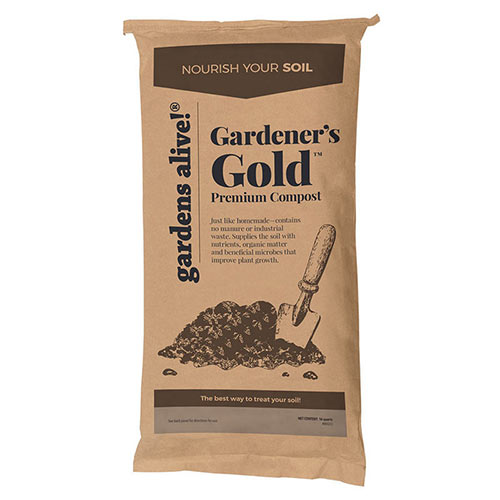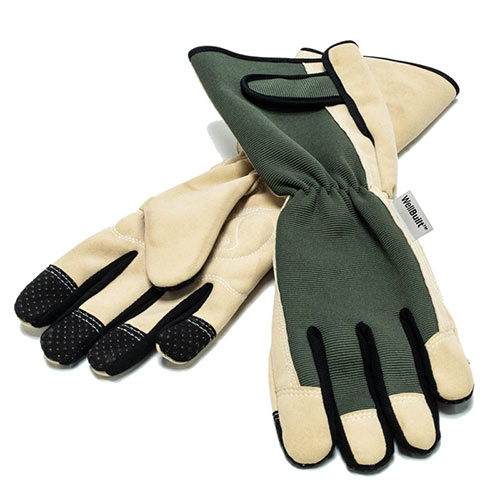Planting Trees & Shrubs--Should You Never Improve the Soil in the Planting Hole?
-
Helpful Products from Gardens Alive!
-
 Gardener's Gold™ Premium Compost
Gardener's Gold™ Premium Compost -
 WellBuilt™ Gauntlet Gloves
WellBuilt™ Gauntlet Gloves
Planting Trees & Shrubs--Should You Never Improve the Soil in the Planting Hole?
Q. Erica, who "lives and gardens in Wheatfield NY, which is right between Buffalo and Niagara Falls", writes: "Last spring I bought a bundle of young serviceberry bushes from my county extension. They were small--about a foot to eighteen inches high apiece. I followed the instructions to first plant them in a "nursery bed." I used a brand-new flowerbed that I had filled with yard waste municipal compost and lots of perlite. They have done well and are leafing out beautifully.
"I'd like to transplant them to their permanent location in my crummy clay soil this fall, which would give them about a year and a half of growing up in the "nursery," but I can't find any instructions on how best to do this. It seems to me that if I dig them up with lots of the loose rich soil they are in now and plant them that way, I will be guilty of "improving the soil in the hole" and thus discouraging them from ever pushing their roots into the crummy clay. But if I dig them out and shake off all the nice soil to plant them "bare root" I fear I will damage the roots and kill them. As you can see, I have just enough knowledge to be dangerous."
A. Actually, you have just enough knowledge to ask a darn good question, Erica! And before I fumble around for an answer, I would like to take a moment to praise your choice of plants. The Serviceberry--aka the June berry, Shad berry and about a dozen other common names--is a remarkable plant. It's native, comes in both the form of a tree and as a multi-branching shrub. It is one of the earliest plants to produce fruit--hence the June berry tag. The fruits are a lot like blueberries and taste like a combination of blueberries and almonds.
...At least the best ones do. Like mulberries, the fruit quality can vary considerably from plant to plant. Some taste great eaten raw; some fruits are fit only for making jam. (Hey--you add enough sugar and anything tastes good.) They are a great plant for wildlife as well--several cool-looking moths and butterflies eat the leaves, many types of birds eat the fruit, and deer will eat the whole thing to the ground if you aren't careful.
Now--you have the principle down perfectly; you would feel like a good parent if you fill the planting hole with nice amendments like potting soil, peat moss, compost, perlite and vermiculite to create a wonderful welcoming environment. But the reality is that the roots of your new plants would stay inside that welcoming environment instead of fighting their way out into your crummy clay. Plants with helicopter parents never seem to grow; and they develop so few lateral roots that you can lift them right out of the ground four or five years down the line.
Are there exceptions? Yes-- blueberries are a big one. They naturally grow in highly acidic peaty soil (aka peat bogs), so you have to backfill their hole with a lot of milled peat moss. With lesser-needy acid lovers like rhododendron and azalea, a mulch of peat covered by a mulch of compost will generally suffice.
Now--your "nursery bed", aka "heeling in", or positioning baby plants in a temporary bed until they're big enough to plant in an area whose soil scares you. You have been a good mother so far--and you are correct that late summer/early fall is the ideal time to plant new trees and shrubs. But I think it's time for your kids to get out of the nursery and into the real world now. Spring is a fine time for planting, especially in your upstate New York clime, where harsh summertime temperatures aren't due until late July and then last three or four days.
Don't dig them up. Soak the soil and pull them up ever so gently. Their new spot must have good drainage (good for clay at least; no ponding) and excellent air circulation, as they are prone to some diseases if over-crowded. Otherwise, assuage your fears by digging a super wide hole; it's okay to bust up the clay; just don't replace it. There's an old expression in this game: "Dig a wide hole; NOT a deep one", so go to town on the sideways action.
Position the plants high up in their planting space. With trees, you have the root flare as a guide; you always want to see the root flare above ground after planting. With shrubs you're going to have to use your best judgement. Breathe, grasshopper; and believe that the plants want to live.
Fill the hole back up with the same crummy clay you dug up--no cheating! Then let a hose just drip at the surface of the soil for several hours for each plant. Let the soil settle, mulch with two inches of your wonderful yard waste compost and have a fast hand with the drip hose if you go a week without rain and or if it gets really hot. (Which you wish; last time I checked, global warming was still scared of your part of the country.)
Added info:
* Bare root plants that have not been heeled in: Soak the roots in a bucket of clean water for several hours before planting as above.
• Plants in pots: Slide the dirt-covered roots out of the pot and use a garden knife to dig in there, get rid of excess soil and loosen up the roots before planting. Don't worry about root injury; you need to shake the nether regions of such plants out of their pot-bound doldrums. Then plant as above.
Q. Erica, who "lives and gardens in Wheatfield NY, which is right between Buffalo and Niagara Falls", writes: "Last spring I bought a bundle of young serviceberry bushes from my county extension. They were small--about a foot to eighteen inches high apiece. I followed the instructions to first plant them in a "nursery bed." I used a brand-new flowerbed that I had filled with yard waste municipal compost and lots of perlite. They have done well and are leafing out beautifully.
"I'd like to transplant them to their permanent location in my crummy clay soil this fall, which would give them about a year and a half of growing up in the "nursery," but I can't find any instructions on how best to do this. It seems to me that if I dig them up with lots of the loose rich soil they are in now and plant them that way, I will be guilty of "improving the soil in the hole" and thus discouraging them from ever pushing their roots into the crummy clay. But if I dig them out and shake off all the nice soil to plant them "bare root" I fear I will damage the roots and kill them. As you can see, I have just enough knowledge to be dangerous."
A. Actually, you have just enough knowledge to ask a darn good question, Erica! And before I fumble around for an answer, I would like to take a moment to praise your choice of plants. The Serviceberry--aka the June berry, Shad berry and about a dozen other common names--is a remarkable plant. It's native, comes in both the form of a tree and as a multi-branching shrub. It is one of the earliest plants to produce fruit--hence the June berry tag. The fruits are a lot like blueberries and taste like a combination of blueberries and almonds.
...At least the best ones do. Like mulberries, the fruit quality can vary considerably from plant to plant. Some taste great eaten raw; some fruits are fit only for making jam. (Hey--you add enough sugar and anything tastes good.) They are a great plant for wildlife as well--several cool-looking moths and butterflies eat the leaves, many types of birds eat the fruit, and deer will eat the whole thing to the ground if you aren't careful.
Now--you have the principle down perfectly; you would feel like a good parent if you fill the planting hole with nice amendments like potting soil, peat moss, compost, perlite and vermiculite to create a wonderful welcoming environment. But the reality is that the roots of your new plants would stay inside that welcoming environment instead of fighting their way out into your crummy clay. Plants with helicopter parents never seem to grow; and they develop so few lateral roots that you can lift them right out of the ground four or five years down the line.
Are there exceptions? Yes-- blueberries are a big one. They naturally grow in highly acidic peaty soil (aka peat bogs), so you have to backfill their hole with a lot of milled peat moss. With lesser-needy acid lovers like rhododendron and azalea, a mulch of peat covered by a mulch of compost will generally suffice.
Now--your "nursery bed", aka "heeling in", or positioning baby plants in a temporary bed until they're big enough to plant in an area whose soil scares you. You have been a good mother so far--and you are correct that late summer/early fall is the ideal time to plant new trees and shrubs. But I think it's time for your kids to get out of the nursery and into the real world now. Spring is a fine time for planting, especially in your upstate New York clime, where harsh summertime temperatures aren't due until late July and then last three or four days.
Don't dig them up. Soak the soil and pull them up ever so gently. Their new spot must have good drainage (good for clay at least; no ponding) and excellent air circulation, as they are prone to some diseases if over-crowded. Otherwise, assuage your fears by digging a super wide hole; it's okay to bust up the clay; just don't replace it. There's an old expression in this game: "Dig a wide hole; NOT a deep one", so go to town on the sideways action.
Position the plants high up in their planting space. With trees, you have the root flare as a guide; you always want to see the root flare above ground after planting. With shrubs you're going to have to use your best judgement. Breathe, grasshopper; and believe that the plants want to live.
Fill the hole back up with the same crummy clay you dug up--no cheating! Then let a hose just drip at the surface of the soil for several hours for each plant. Let the soil settle, mulch with two inches of your wonderful yard waste compost and have a fast hand with the drip hose if you go a week without rain and or if it gets really hot. (Which you wish; last time I checked, global warming was still scared of your part of the country.)
Added info:
* Bare root plants that have not been heeled in: Soak the roots in a bucket of clean water for several hours before planting as above.
• Plants in pots: Slide the dirt-covered roots out of the pot and use a garden knife to dig in there, get rid of excess soil and loosen up the roots before planting. Don't worry about root injury; you need to shake the nether regions of such plants out of their pot-bound doldrums. Then plant as above.
-
Helpful Products from Gardens Alive!
-
 Gardener's Gold™ Premium Compost
Gardener's Gold™ Premium Compost -
 WellBuilt™ Gauntlet Gloves
WellBuilt™ Gauntlet Gloves







 Gardens Alive! & Supplies
Gardens Alive! & Supplies




